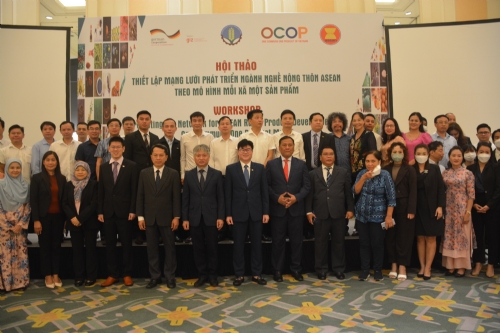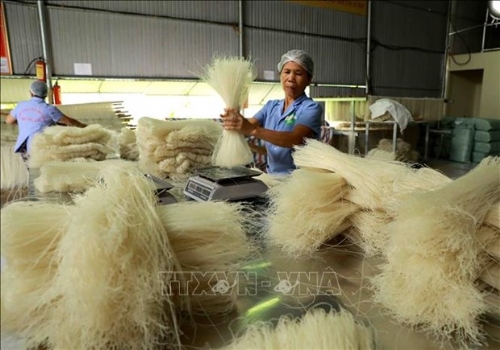IMF predicts Vietnam’s GDP growth at 6.5% in 2019
Tuesday, July 23, 2019 09:23

A soft landing of Vietnam's growth is expected in 2019 to 6.5%, below the government's target at 6.7%, as credit growth tightens and major trading partner growth decelerates, according to the International Monetary Fund (IMF).

Vietnam's selected economic and financial indicators, 2014–2020. Source: IMF. |
Meanwhile, headline inflation is projected at 3.6%, and core inflation at 2.1%. Over the medium term, growth is expected to slow down to a more sustainable pace of growth of 6.5%, consistent with the implementation of ongoing reforms, including privatization and reducing the economic role of the state, and constraints from infrastructure and other structural gaps and fiscal consolidation. Inflation is likely to remain close to target, 4% per annum.
External risks from slower partner country growth and trade policy uncertainty remain elevated; they dominate the balance of risks, stated the IMF.
Additionally, banking sector fragilities continue to pose risks, although the bank recapitalization under way is a mitigating factor, while bottlenecks related to the anti-corruption campaign could delay investment.
On the upside, Vietnam’s numerous free trade agreements (FTAs) could usher in productivity gains. Growth could also surprise on the upside if trade diversion and investment relocation effects continue.
Vietnam’s external position in 2018 was substantially stronger than warranted by fundamentals. The Current Account (CA) gap reached 6.4% of GDP and exchange rate undervaluation 8.4%.
International reserves rose to US$65 billion, 24% of GDP and 76% of the assessing reserve adequacy (ARA) metric at end-April 2019.
The gap reflects domestic distortions and residual dualism in Vietnam’s economy - especially barriers to accessing land, credit and an uneven playing field for domestic private firms - that discourage private domestic investment. More ambitious structural reforms are needed to: strengthen private investment; improve the efficiency of public investment; greater two-way exchange rate flexibility. And while Vietnam’s commitment to diversify trade is strong, there is more room to tackle domestic trade barriers, especially non-tariff ones.
Moving up global value chain
A competitive FDI manufacturing sector generates a large trade surplus (15% of GDP), dominated by electronics multinationals and apparel producers engaged in processing and final assembly.
 |
Vietnam is becoming highly integrated into the global supply chain - both forward and backward linkages - while moving up the value chain, mainly in high-tech manufacturing.
Nevertheless, it is worth mentioning that the domestic non-FDI sector (many SMEs, agriculture, tradable goods producers, including SOEs and domestic private firms) runs a trade deficit of 8.3% of GDP. Productivity in this sector is low (20% of that of the FDI sector), and exports are dominated by agricultural commodities and oil.
Slow SOE reform progress, barriers faced by SMEs to reach economies of scale and credit misallocation and weaknesses in financial intermediation impede the development of a productive and vibrant economy outside the FDI sector despite rapid growth.
Hai Yen
Other news
- HANOI: Promoting the consumption of craft village products and developing community tourism(11/5/2022 3:16:04 PM)
- Chuong My: Effectiveness from the One Commune One Product Program(11/3/2022 10:04:10 AM)
- Thanh Hoa develops OCOP products(11/1/2022 1:30:31 PM)
- Promoting the network for Asia Rural Product Development on one commune one product(8/30/2022 9:43:23 AM)
- Phu Tho eyes 56 new 3-star OCOP products for 2022(8/23/2022 3:09:56 PM)
- Opening of the OCOP product introduction week in Hanoi in 2022 in Phuc Tho district(8/1/2022 3:28:38 PM)
- Shipping route connecting central Vietnam, India inaugurated(7/29/2022 11:22:05 AM)
- Reference exchange rate down 4 VND on July 27(7/27/2022 11:42:14 AM)
- WB, Japan support greater access to legal services for the poor in Vietnam(7/27/2022 11:37:13 AM)
- Evaluation and classification of OCOP products Hoan Kiem District in 2022(7/27/2022 10:10:23 AM)
The featured news
-
HANOI: Promoting the consumption of craft village products and developing community tourism
-
Promoting the network for Asia Rural Product Development on one commune one product
-
Phu Tho eyes 56 new 3-star OCOP products for 2022
-
Opening of the OCOP product introduction week in Hanoi in 2022 in Phuc Tho district
-
Shipping route connecting central Vietnam, India inaugurated






